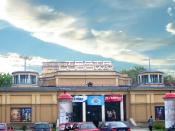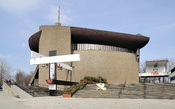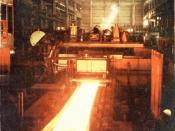There are few examples in the world where the symbolic juxtaposition of a nation's past and future are as striking as they are in Poland. Throughout the country there are endless images representing an uneasy coexistence of a communist past in combination with a rapid move to the market economy. Yet perhaps the starkest change in terms of symbolism is most apparent in the purpose built socialist town of Nowa Huta. Nowa Huta was constructed from scratch, funded by the Soviet Union to represent the proletarian opponent to the 'intellectual and Catholic' Kraków. Together with Magnitogorsk in Russia Nowa Huta was one of only two purpose built socialist cities in the world and was also arguably the greatest symbol of socialist ideological failure. Nowa Huta is indeed loaded with astounding contradictions but such contradictions are much more than symbolic and to a great extent embody the far reaching political, economic, and social paradoxes found throughout Poland.
Along with the shipyards in Gdansk Nowa Huta was one of the most important Solidarity strongholds and by 1983 it had been the site of some of the most violent protests in support of Solidarity. The importance of this free trade union to the eventual demise of communism in Poland can not be overplayed. Throughout the communist era there was always a widespread opposition to the imposed socialist regime but after years of fragmentation it was undeniably the consolidation of various social groups, such as the intelligentsia and students but most importantly the working class which was to prove the turning point of opposition. In the summer of 1980 Polish protests shifted in gear, "within the country of thirty-five million citizens, an independent union of ten million working people was formed" (Korab-Karpowicz). It was known as the Independent Self-Governing Trade Union Solidarity. An incredibly powerful political force which throughout the eighties made extensive social and economic reforms, when in 1989 Poland held its first free elections Solidarity won all but one of the seats enjoying a public approval rating of over 90%.
The irony is that the labor union which helped to bring about the fall of the communist government found itself opposing the forces which it helped to unleash.(Aleksandrowicz 1998) Moreover it is the workers, the most powerful voice within the movement, are now bearing the brunt of Poland's economic down resulting from "shock therapy" Currently Poland's main economic problem is unemployment, which has remained at 18% for the last two years, unemployment at present amounts to about 20%.(Cave 2001)This poses a particular problem for the Polish government because the continuous rise in productivity due to rationalization particularly in the industrial sector will put yet more people out of work.
Post-communist transformation has seen the industrial sectors shrink in relation to GDP; at the same time, the service sector has grown rapidly. These shifts are evident in all indicators of economic structure--GDP,(Unit 2003) sales and employment. Industry declined as a share of GDP at basic prices from around 40% in the late 1980s to 24% in 2001.The declining role of the industrial sectors is no where as profound as in Nowa Huta, which has been described was as not a town with a steelworks but rather a steelworks with a town. Nowa Huta was built around Huta Lenilia a huge state owned industrial complex which at its height employed over forty seven thousand people the overwhelming majority of the towns working population, renamed Huta Sendzimizra in the steelworks is no longer owned by the state but by LMP holdings an Indian transnational company, today it employs no more than seven thousand people.
The share of GDP accounted for by services stood at 65% in 2001, and its expansion is continuing.(Unit 2003) Under communism there was a barely existent commercial sector, the fall of the regime has provided an opening for such development. Although the decline of the industrial sector is by no way matched by the growth in commercial activities it can be seen that throughout Nowa Huta there is a visible emergence of new enterprise. This is in the form of both local shops, which are opening on the ground floors of the apartment blocks as well as accumulating in shack style complexes which sit in stark contrast to the archetypal communist architecture. On the tram route out of Nowa Huta on one such block was an interesting advertisement which captured the spirit of this new phase in Nowa Huta and by extension Poland as a whole. The image which took up one side of the building was a Coca Cola advertisement, which in its self for me represented a contradiction in terms the classic image of globalization and capitalism painted onto the classic image of communism, what made it doubly resonate was the picture of a man playing the bottle as a bugle a play on the trumpeter in the tower in Krakow. Nowa Huta was located in this particular site to offset the traditional bourgeois of Krakow it now embraces and in fact advertises it.
The development of Nowa Huta is continually expanding. An "economic zone" on the road between the town and Krakow has been constructed. Tax concessions were offered to employers who located here, it was aimed to encourage the creation of modern technologies such as computer software and micro chips. However the majority of jobs formed in the area were outside the realm of manufacturing. Although more than a thousand new jobs have been created they were typically in the service sector particularly hypermarkets such as Tesco and Ikea. The rebirth of this entrepreneurial activity and the structural change in employment is replicated throughout Poland.
Such a change has had a dramatic impact on people's sense of identity with often devastating consequences. Nowa Huta has propagated a widely diverging and often conflicting representation of its identity. It was built to reflect Socialist ideals the but image of a straightforwardly proletarian community proved hard to sustain. (Oppenheim 1995)The town and its community was built from scratch and as a consequence the population of Nowa Huta was overwhelmingly of peasant origin as Fisher notes, "rural attitudes were incorporated into the newly constructed urban environment" this was done both in a symbolic way holding onto traditional customs of the countryside but also in a very literal way to the extent that rural workers raised pigs in baths and insisted on tending gardens.
Also the largely conservative attitudes of such a population made it problematical for the authorities to impose its atheistic ideologies as the community, devoutly Catholic, was not prepared to sacrifice its religion. Nowa Huta was built without a single church as Stenning points out in her article; The Politics of Work, Workplace and Community in Nowa Huta, many of the early struggles in the town were focused around calls for the construction of a church. The people of Nowa Huta first erected a wooden cross in the heart of the town1957 and replaced this with a steel cross on April 27th 1960. The irony of a steel cross in a steel community can not be escaped.(Stenning 2003) The role of the church in Nowa Huta at first represented rural conservatism but went onto play an important function in the representation of many of the worker based resistance.
As a result of years of communist proper gander stressing the importance of the worker to the point of hero worship, depicted with amazing clarity in Andrzej Wajda' s famous Man of Marble, Nowa Huta presents us with another striking paradox. Poland has to now live with the consequences of the change in social value of the worker who has suffered immensely not only with the financial implications of the industrial decline but the equally destructive loss of the workers' social status. Nowa Huta built as the workers paradise has become the workers nightmare with few opportunities for those it enticed here. This pattern is certainly widespread throughout the main industrial sectors of Poland such as Gdansk , Katavitce and Gdynia. Such a loss of identity has led to many social problems such as alcoholism but also very new dilemmas for example drug misuse and trafficking as well as rise in crime, matters which were not present during the iron hand of communism. Problems are particularly widespread in Nowa Huta it is not an uncommon to witness crowds of men sitting with nothing more to do than drink vodka from morning to evening while their wives eek out a living in the local hypermarket To some extent Nowa Huta provides us with a microcosm of some of difficulties confronting Poland in the transition to a market economy and further into the European Union. However certain social groups are more heavily affected than other and it is the working classes which are enduring the most negative aspects of such transformations. As a town which was composed wholly from the working class the problems of Poland in general are more heavily concentrated in industrial areas particularly Nowa Huta.
.


